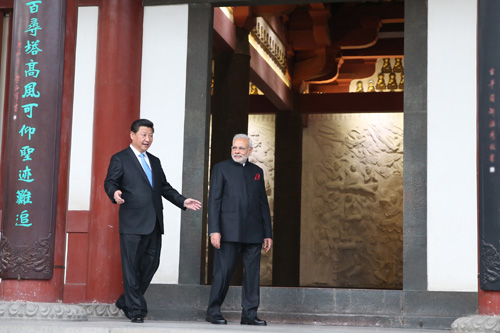|
 |
|
President Xi Jinping accompanies Prime Minister Narendra Modi to visit Daci'en Temple after their formal meeting on May 14 (XINHUA) |

Prime Minister Narendra Modi has just completed a productive and positive visit to China. The three-day visit, from May 14-16, was rich in symbolism and substance and has taken the relationship between India and China to new heights. Coming just eight months after the landmark visit of President Xi Jinping to India, it has opened up a new chapter in India-China relations.
The Prime Minister's visit was rich in symbolism, reflecting the growing closeness between India and China. For the first time, President Xi travelled outside Beijing to receive a foreign leader, in Xi'an in his home province of Shaanxi. President Xi also accompanied Prime Minister to the Big Wild Goose Pagoda--itself a symbol of the shared legacy of our two great civilizations--and organized a grand welcome ceremony at the Xi'an city wall. Premier Li Keqiang joined Prime Minister at the Yoga-Taichi performance with the world heritage site of Temple of Heaven as the backdrop, the first ever such event, which highlighted the cultural connectivity between the two countries. And, who can forget Prime Minister Modi's "selfie" with Premier Li which has gone viral with over 33 million hits on the Weibo when I last checked? The level of reception accorded to Prime Minister was unprecedented, to say the least. As Prime Minister remarked, this was not merely a reception for him or his delegation, but a reflection of the increased importance that both India and China attach to relations with each other.
The results achieved are also impressive. There were 24 agreements signed on the government-to-government side, 26 MoUs on the business-to-business side and two joint statements, including one on climate change. These deliverables look phenomenal when we consider that substantial outcomes were achieved last September when President Xi visited India. The fact that India and China could come up with over 50 outcome documents in just eight months reveals the huge potential that exists between our two countries, as well as the efforts that we have made to elevate our partnership.
The understandings on multiple aspects of functional cooperation reflect a follow-up to the Closer Developmental Partnership that we established last year, besides an exploration of new avenues for cooperation. The inter-governmental agreements covered, as Premier Li said, areas from the heaven to the earth! They included such diverse fields as space cooperation, earthquake engineering, ocean sciences, mining, railways, skill development, education, culture, Yoga, tourism and many more.
The strength of our economic partnership could be gauged from the business events in Shanghai. Prime Minister interacted with 21 CEOs of leading Chinese companies and the response was so positive that the meeting went far longer than scheduled. Over 40 prominent Indian CEOs attended the business forum along with their counterparts from China. The 26 business understandings worth over $22 billion signed at the forum covered such varied sectors as industrial parks, renewable energy, thermal energy, telecommunication, steel, capital goods, IT and media. Besides, there was a clear consensus among the leaders of the two countries on correcting the existing imbalance in the bilateral trade and injecting sustainability into it. With this in mind, they agreed to establish a high-powered task force that will go into issues relating to the trade deficit as well as expansion of economic engagement.
There was, moreover, an action-oriented accord on broad-basing our partnership, as could be seen from the range of agreements signed and in the establishment of new dialogue mechanisms, such as the one between the DRC [State Development Research Center] and the NITI Aayog [National Institution for Transforming India Aayog] and the Think Tanks' Forum, besides a bilateral consultative mechanism on WTO negotiations. Three new institutions are being launched in partnership, the Centre for Gandhian and Indian Studies in Shanghai, Yoga College in Kunming, and National Institute for Skill Development and Entrepreneurship in Ahmedabad.
We also decided to establish new consulates in each other's country, in Chengdu and Chennai and to expand our interactions at the sub-national level. Two agreements signed--one on cooperation between the Indian Ministry of External Affairs and the International Department of the Central Committee of the Communist Party of China and another on the establishment of a State/Provincial Leaders' Forum--reflect this understanding. Prime Minister Modi and Premier Li addressed the opening session of the new forum, which is a significant initiative, considering that this is the first time that India has established such a dialogue mechanism with any country. It fits into the concept of "cooperative federalism" that is dear to our Prime Minister and is, as Premier Li put it, a "smart choice!" We have also increased the number of sister-city and sister-state relations. All these are reflective of the fact that our relationship has grown so big that we cannot do full justice to our partnership from just Beijing or New Delhi.
Expanding people-to-people exchanges and cultural contacts figured as a major theme of the visit. Prime Minister's visit to the Great Wild Goose Pagoda, joined by President Xi, and his attendance at the Yoga-Taichi event along with Premier Li exemplified the importance that our leaders attach to tapping the shared cultural heritage. There is recognition that, despite being neighbors with contacts spanning two millennia, our people know very little of each other. In a bid to correct this, Prime Minister announced the extension of the e-visa facility to Chinese nationals wishing to travel to India. His actions also emphasized the people-to-people dimension of our relationship where he attempted to connect with the people of China--when he opened his Weibo account and also assured the netizens that he will continue to interact with them; when he got down from his car and went into the cheering crowd at Xi'an; when he interacted with the children who performed Yoga and Taichi; when he spoke in Chinese at Tsinghua University to rapturous applause from the crowd and to appreciation from Foreign Minister Wang Yi; and in his speech at the reception hosted by the Indian community in Shanghai, the largest ever gathering of the community in the region.
The visit also went on to deliver a message to the international community on cooperation between India and China. There was agreement among the leaders that our relationship is poised to play a defining role in the 21st century in Asia and beyond, with the recognition that the simultaneous re-emergence of India and China as two major powers would have a profound impact on the course of this century. The Joint Statement has a separate section on "shaping the regional and global agenda" where India and China, as two major poles in the global architecture, agree to cooperate on a host of issues ranging from WTO, climate change and terrorism to regional organizations. In this regard, the leaders have agreed to enhance strategic communication and coordination.
The Prime Minister's talks with President Xi and Premier Li were candid, constructive and friendly, covering all issues, including those that trouble the smooth development of our relations. The leaders agreed that as we move ahead, we should be sensitive to each other's interests; strengthen mutual trust and confidence; continue to manage our differences with maturity; and seek solutions to outstanding issues which hold us back from realizing the full potential of our partnership. There was recognition of the historic responsibility to turn this relationship into a source of strength for each other and a force of good for the world.
In all, it is fair to say that the visit of Prime Minister Modi took our strategic partnership to a new level. A positive message has gone out, not only to the people of our two countries but also to the international community that our two countries are willing to take a strategic and long-term view of our relationship so as to contribute to Asia and the world. This visit has set a new direction between the two largest developing countries, which must grow in tandem to realize the vision of an Asian century.
The author is the Indian Ambassador to China
Copyedited by Kylee Mclntyre
Comments to liuyunyun@bjreview.com
|
